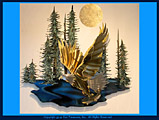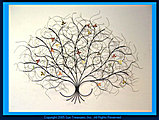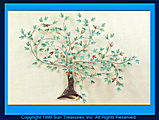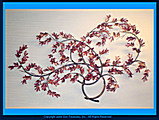Metals and Techniques
Most metal wall art is formed from steel, brass, copper or aluminum. The metals are cut, shaped, textured and welded to form scenes or abstract shapes in a variety of sizes. Artists use various methods to cut and shape the metals, including cutting torches, plasma cutters, stamping dies and computer controlled cutting machines. Color is added by applying heat, patinas, enamels, or paint. Surface textures are developed by embossing, etching, grinding and polishing. Although shaping and coloring are important elements of creating a metal wall sculpture, it is the composition of the sculpture that determines its appeal. The four samples below illustrate some of the different techniques used. If you wish to see the item in our catalog, click the link below the image.
"American Dream" by Ken Scott employs mild steel
and proprietary heat treating techniques.
and proprietary heat treating techniques.
Bovano of Cheshire uses the unusual technique of fusing a colorful glass coating over a copper backing to achieve remarkably vivid colors
Gurtan's "May Tree" uses copper-plated steel wire to form this large metal wall hanging. Copper and brass are used for the leaves.
Max Howard works in copper and brass. Below is his "Windswept Maple" featuring a hammered copper trunk with a brown patina, and coper leaves with red and green patinas. Patinas can be formed from heat treating or applying an ammonia sulfate wash that mimics long term exposure to the elements.
Max's "Windy Willow" incorporates copper leaves that are heat treated to achieve a deep, rich red color. In other sculptures Max uses polished brass or natural copper to achieve the colors desired.
Follow the links below for additional information and "how to" suggestions.
How To Get Started
How to Hang Metal Wall Art
Proper Lighting
How to Clean and Maintain Metal Sculptures
Metal Wall Art for Outdoors
Purchase or Commission?
How To Get Started
How to Hang Metal Wall Art
Proper Lighting
How to Clean and Maintain Metal Sculptures
Metal Wall Art for Outdoors
Purchase or Commission?




